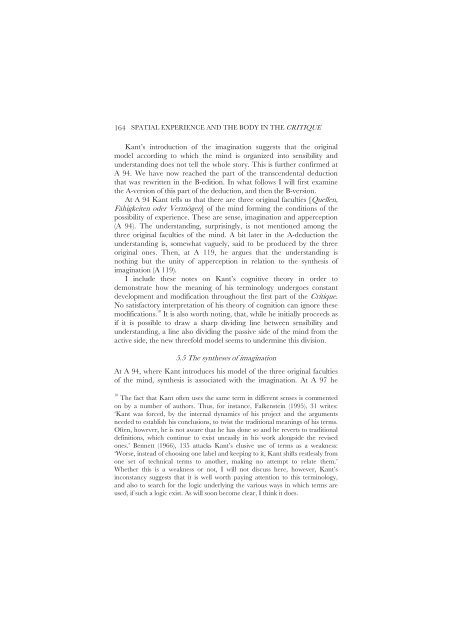BODY AND PRACTICE IN KANT
BODY AND PRACTICE IN KANT
BODY AND PRACTICE IN KANT
Create successful ePaper yourself
Turn your PDF publications into a flip-book with our unique Google optimized e-Paper software.
164<br />
SPATIAL EXPERIENCE <strong>AND</strong> THE <strong>BODY</strong> <strong>IN</strong> THE CRITIQUE<br />
Kant’s introduction of the imagination suggests that the original<br />
model according to which the mind is organized into sensibility and<br />
understanding does not tell the whole story. This is further confirmed at<br />
A 94. We have now reached the part of the transcendental deduction<br />
that was rewritten in the B-edition. In what follows I will first examine<br />
the A-version of this part of the deduction, and then the B-version.<br />
At A 94 Kant tells us that there are three original faculties [Quellen,<br />
Fähigkeiten oder Vermögen] of the mind forming the conditions of the<br />
possibility of experience. These are sense, imagination and apperception<br />
(A 94). The understanding, surprisingly, is not mentioned among the<br />
three original faculties of the mind. A bit later in the A-deduction the<br />
understanding is, somewhat vaguely, said to be produced by the three<br />
original ones. Then, at A 119, he argues that the understanding is<br />
nothing but the unity of apperception in relation to the synthesis of<br />
imagination (A 119).<br />
I include these notes on Kant’s cognitive theory in order to<br />
demonstrate how the meaning of his terminology undergoes constant<br />
development and modification throughout the first part of the Critique.<br />
No satisfactory interpretation of his theory of cognition can ignore these<br />
modifications. 10 It is also worth noting, that, while he initially proceeds as<br />
if it is possible to draw a sharp dividing line between sensibility and<br />
understanding, a line also dividing the passive side of the mind from the<br />
active side, the new threefold model seems to undermine this division.<br />
5.5 The syntheses of imagination<br />
At A 94, where Kant introduces his model of the three original faculties<br />
of the mind, synthesis is associated with the imagination. At A 97 he<br />
10<br />
The fact that Kant often uses the same term in different senses is commented<br />
on by a number of authors. Thus, for instance, Falkenstein (1995), 31 writes:<br />
‘Kant was forced, by the internal dynamics of his project and the arguments<br />
needed to establish his conclusions, to twist the traditional meanings of his terms.<br />
Often, however, he is not aware that he has done so and he reverts to traditional<br />
definitions, which continue to exist uneasily in his work alongside the revised<br />
ones.’ Bennett (1966), 135 attacks Kant’s elusive use of terms as a weakness:<br />
‘Worse, instead of choosing one label and keeping to it, Kant shifts restlessly from<br />
one set of technical terms to another, making no attempt to relate them.’<br />
Whether this is a weakness or not, I will not discuss here, however, Kant’s<br />
inconstancy suggests that it is well worth paying attention to this terminology,<br />
and also to search for the logic underlying the various ways in which terms are<br />
used, if such a logic exist. As will soon become clear, I think it does.
















